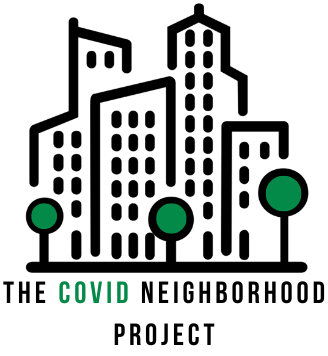The COVID Neighborhood Project

What is CONEP?
The COVID Neighborhood Project is a data collation effort whose aim is to collect and curate neighborhood-level COVID-19 case data from throughout the pandemic for all 50 states in the U.S. We work with state health departments to secure the COVID-19 data in accordance with all the necessary protections from the state health department. Check out our progress so far:
| State | COVID-19 Data | Level of Geography |
|---|---|---|
| Arizona | cumulative case counts | ZCTA |
| Delaware | total cases, average daily rate, SARS-CoV-2 tests, testing rate, vaccine distribution | Census Tract |
| Florida | cumulative case counts | ZCTA |
| Illinois | cumulative confirmed cases, total tested | ZCTA |
| Indiana | cumulative case counts | ZCTA |
| Louisiana | weekly case counts, weekly test count, test positivity rate, since Feb 2020 | Census Tract |
| Maine | cumulative case counts | ZCTA |
| Maryland | daily case counts since April 2020 | ZCTA |
| Minnesota | weekly case counts since May 2020 | ZCTA |
| New Mexico | cumulative case counts, deaths, SARS-CoV-2 tests, hospitalizations | Census Tract |
| North Carolina | cumulative case counts, case rate, total COVID-19 deaths | ZCTA |
| Nevada | cumulative case counts | ZCTA |
| Ohio | cumulative case count, 30-day cases, 14-day cases | ZCTA |
| Oklahoma | cumulative case counts, deaths | ZCTA |
| Oregon | cumulative case counts | ZCTA |
| Pennsylvania | cumulative case counts | ZCTA |
| Rhode Island | cumulative case counts | ZCTA |
| Vermont | cumulative case counts | ZCTA |
| Virginia | weekly case counts since May 2020 | ZCTA |
| Wisconsin | cumulative case counts, deaths, SARS-CoV-2 tests, hospitalizations | Census Tract |
What will we do with CONEP?
- At CONEP we are working towards building a national database of neighborhood COVID-19 data that can be used by researchers, policy-makers, and the public to understand how COVID-19 has been distributed during the pandemic.
- The CONEP can first tell us something about how COVID-19 has been distributed across neighborhoods in the U.S. Take a look at the map below which shows cumulative case counts per 100,000 split into deciles for the 21 states we currently have.
- The CONEP data is linked with data from the National Neighborhood Data Archive (NaNDA) so we can understand what features of the neighborhood environment might tell us about the ways in which COVID-19 has affected certain neighborhoods.
- As we continue to look at these patterns, our hope is that we can use these findings to help bring support to communities that have been hit the hardest. At CONEP, we believe that consequences of COVID-19 extend far beyond the number of cases—though that is an important metric. COVID-19 has significantly impacted many people’s social and economic wellbeing too and the social and economic wellbeing of entire communities.

Figure 1: Map of the entire U.S. showing which states CONEP has data for and showing declines of COVID-19 case rates
Are the CONEP data available for public use yet?
We are just finishing our first analyses of the CONEP data which looks at relationships between neighborhood-level factors (example: socioeconomic status) and COVID-19 burden. Our initial findings can be found in State Variation in Neighborhood COVID-19 Burden: Findings from the COVID Neighborhood Project. We are also developing a strategy with ICPSR to make these data available to the wider community. Stay tuned for more updates! Contact us at: [email protected]
Funding Support: The CONEP project has received support from the National Institute of Aging-funded Network on Life Course Dynamics and Disparities in the 21st Century (R24 AG045061).

